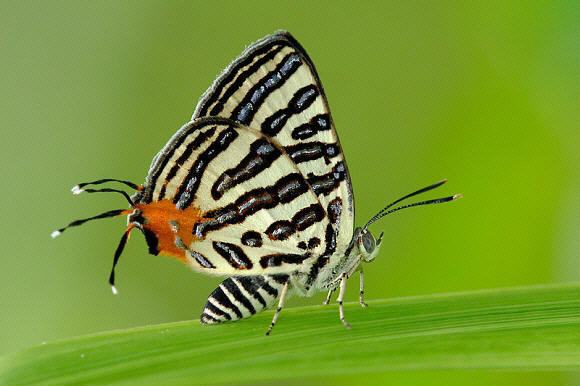
Introduction
The genus Spindasis is regarded by some authors as a subgenus of Cigaritis. Thus defined there are well over 70 species, found variously across Africa, the Middle East and the Oriental region. The ‘true’ Spindasis species, i.e. those occuring in the Oriental region, amount to about 25-30 species. The classification of some taxa is disputed so the exact number of species in India is uncertain. D’Abrera lists 14 species as occuring on the Indian subcontinent – syama, lohita, vulcanus, elwesi, schistacea, trifurcata, evansii, lilacinus, nipalicus, rukma, rukmini, abnormis, nubilus and ictis but it is likely that some of these are only worthy of subspecies status.
The genus is instantly recognisable from the distinctive pattern of red-bordered silvery stripes on the underside. The pattern functions to divert the eyes of predators away from the butterfly’s head, and towards the tornus. The bright orange tornal spot, and the white-tipped ‘false antennae’ tails, which are wiggled while the butterfly rests, add further to the back-to-front illusion. A bird or reptile intending to attack a butterfly will always try to anticipate the direction in which it will try to escape. Accordingly they aim their attack just ahead of what they believe to be the head of the insect, but the back-to front illusion fools them into aiming at the tail, and the butterfly is able to escape in the opposite direction.
Spindasis syama is found in north-east India, Myanmar, Thailand, Malaysia, and Borneo.
Habitats
This is a forest insect, usually seen in light gaps or along wide trails at elevations between sea level and about 500m.
Lifecycle
The larva feeds on the foliage of Dioscorea, Xylia and Psidium and is attended by Crematogaster ants, which ‘milk’ it to obtain sugary secretions. It lives, and eventually pupates, within a shelter made by binding together leaves with silk.
Adult behaviour
Both sexes are usually encountered singly. They often rest on the foliage of trees or shrubs. The flight is rapid, erratic and difficult to follow with the eye.
Males sometimes visit sandbanks, where they perch on rocks or stones. Upon landing they wiggle the ‘false antennae’ tails for a few moments, but once they have assessed that they are in no immediate danger from predators, they stop this activity and remain perfectly still.
